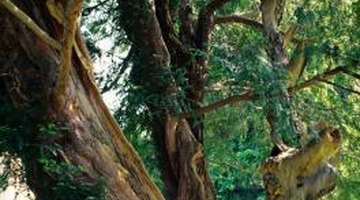Trees That Are Used to Make Bows & Arrows
Arrows have been used for hunting for at least 30,000 years. Bows, too, have been used for thousands of years. In Denmark, a bow found in a bog dated back to 8,000 to 6,000 BC. In 1991, Otzi, a hunter from 3,300 BC, was found frozen on the Similaun Glacer, along with his unfinished bow and a quiver with 14 arrows. Many of the same trees used to make bows and arrows in the past are still used today.
Yew

The unfinished bow found with Otzi was made of wood from the yew tree. Yew wood is a traditional bow-making wood and remains the standard bow wood today. Yew wood has the ideal characteristics for bows--it is strong and elastic, so that bows made from the wood can be made both narrow and thick.
Osage Orange
American Indians made bows with wood from the osage orange tree. Today, osage orange is still a popular wood for bows. Like yew wood, osage orange wood is strong, yet elastic enough to support repeated bending and stretching.
Other Trees
Bows are made from the wood of many trees. Hard woods such as hickory, white ash, elm, oak, maple and beech are suitable for making bows, although each wood has different hardness and elasticity. A bow can be made out of any wood, but bows made from soft woods such as pine and sycamore may break under tension. The choice of wood used to make a bow determines the bow’s final weight, color and drawing strength.
Trees for Arrows
Arrows are made from various woods, depending on their end use. The lightweight wood of Port Oxford cedar is the wood of choice for target arrows, while the harder wood of birch trees is better suited for hunting large game. Arrows are made from a variety of other woods including Norway pine, Douglas fir, hazel, bamboo, dogwood, cedar and hickory.
References
- “Bows & Arrows of the Native Americans: A Step-by-Step Guide to Wooden Bows, Sinew-Backed Bows, Composite Bows, Strings, Arrows, and Quivers”; Jim Hamm; 2007
- Pete Ward: Woods
Resources
Writer Bio
Drue Tibbits is a writer based in Central Florida, where she attended Florida Southern College. Her articles have appeared in Entrepreneur and Your Home magazines. She has also been profiled in the Florida Today newspaper and the Writer's Digest magazine. In addition to writing brochure copy for local businesses, she helps new start-up companies develop a local image presence.
Photo Credits
- David Toase/Photodisc/Getty Images
More Articles


